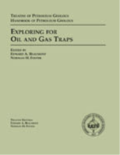Limitations of quantitative fault seal analysis
Jump to navigation
Jump to search
| Exploring for Oil and Gas Traps | |

| |
| Series | Treatise in Petroleum Geology |
|---|---|
| Part | Predicting the occurrence of oil and gas traps |
| Chapter | Evaluating top and fault seal |
| Author | Grant M. Skerlec |
| Link | Web page |
| Store | AAPG Store |
Quantitative fault seal analysis is a proven tool in numerous basins. There are, however, limitations.
Limitations
The limitations of quantitative fault seal analysis follow:
- It applies only to faulted interbedded sandstone and shale sequences. It is not applicable to massive carbonate, chert, or sandstone reservoirs. It has yet to be tested in interbedded shale–carbonate sequences.
- The seal or leak threshold shale gouge ratio (SGR) must be empirically calibrated for each basin, using known sealing and leaking faults. An SGR threshold for the Gulf Coast cannot be used for assessing prospects in the Gippsland basin. The confidence with which a seal can be risked is thus much greater in a production setting or mature basin than it is in a frontier setting.
- It does not apply to all structural styles, and specifically it does not necessarily apply to faults in foreland fold and thrust belts or strike-slip basins. All basins in which quantitative fault seal analysis has been proven to date are dominated by detached or basement-involved normal faults.
- Cataclasis, diagenetic effects, localized fracturing, sharp changes in the permeability or displacement pressure of sands, reactivation of earlier normal faults in compression, “shale-outs,” and the lack of lateral sand continuity in fluvial sequences can affect seal behavior.
- The ability to predict fault seal behavior is only as good as the ability to predict the stratigraphy and structure. As with most variables in prospect assessment, uncertainties in structure and stratigraphy lead to a minimum, maximum, and most likely fault seal risk.
See also
- Quantitative fault seal analysis
- How fault zones affect seal
- Quantitative fault seal analysis
- Fault seal analysis example: Gulf Coast